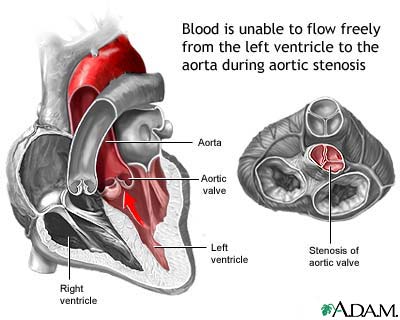
Aortic stenosis

Aortic stenosis is a heart valve disorder that narrows or obstructs the aortic valve opening. Narrowing of the aortic valve prevents the valve from opening properly and obstructs the flow of blood from the left ventricle to the aorta. This can reduce the amount of blood that flows forward to the body.
Alternative names Return to top
Aortic valve stenosis
Definition Return to top
The aorta is the large artery that originates in the left ventricle (lower chamber) of the heart. Aortic stenosis is the narrowing or obstruction of the heart's aortic valve, which prevents it from opening properly and blocks the flow of blood from the left ventricle to the aorta.
Causes, incidence, and risk factors Return to top
As the aortic valve becomes more narrow, the pressure increases inside the left heart ventricle. This causes the left heart ventricle to become thicker, which decreases blood flow and can lead to chest pain. As the pressure continues to increase, blood may back up into the lungs and you may feel short of breath. Severe forms of aortic stenosis prevent enough blood from reaching the brain and rest of the body. Lightheadedness and fainting can result.
Aortic stenosis may be present from birth (congenital), or it may develop later in life (acquired). It is caused by many disorders. One common cause is rheumatic fever, a complication of untreated strep throat. Calcification of the valve can also cause this condition. In this case, the condition is usually not seen until a person reaches their 70s.
Aortic stenosis occurs in approximately 5 out of every 10,000 people. It is more common among men.
Symptoms Return to top
Note: Aortic stenosis may show no symptoms until late in the course of the disease.
Signs and tests Return to top
The health care provider will be able to feel a vibration or movement when placing the hand over the heart. A heart murmur, click, or other abnormal sound is almost always heard through a stethoscope. There may be a faint pulse or changes in the quality of the pulse in the neck. A change in neck pulse is called pulsus parvus et tardus.
Blood pressure may be low.
The following tests may be performedn:
This disease may also alter the results of the following:
Treatment Return to top
If there are no symptoms or symptoms are mild, you may only need to be monitored by a health care provider. If symptoms are moderate to severe, you may need to stay in the hospital.
Medications can include diuretics, digoxin, and other medications to control heart failure. Symptomatic people may be advised to avoid strenuous physical activity. People with symptoms of aortic stenosis (difficulty breathing, chest pain, fainting episodes) should have a physical exam every 6 to 12 months and an ECG performed every 1 to 3 years.
Surgery to repair or replace the valve is the preferred treatment for patients who have symptoms. Some high-risk patients are poor candidates for heart valve surgery. A less invasive procedure called balloon valvuloplasty may be done instead. This is a procedure in which a balloon is placed into an artery in the groin, advanced to the heart, placed across the valve, and inflated. This may relieve the obstruction caused by the narrowed valve.
Expectations (prognosis) Return to top
Aortic stenosis can be cured with surgery, although there may be a continued risk for arrhythmias, which can sometimes cause sudden death. The person may be symptom-free until complications develop. Without surgery, a patient who has signs of angina or heart failure may do poorly.
Persons with aortic stenosis, particularly moderate and severe forms, should not participate in strenuous activities, such as competitive sports.
Complications Return to top
Calling your health care provider Return to top
Call your health care provider if symptoms indicate the possibility of aortic stenosis.
Call your health care provider if aortic stenosis has been diagnosed and symptoms worsen or new symptoms develop.
Prevention Return to top
Treat strep infections promptly to prevent rheumatic fever, which can cause aortic stenosis. This condition itself often cannot be prevented, but some of the complications can be.
Notify the health care provider or dentist about any history of heart valve disease before treatment for any condition. Any dental work, including cleaning, and any invasive procedure can introduce bacteria into the bloodstream. This bacteria can infect a weakened valve causing endocarditis.
Follow the health care provider's treatment recommendation for conditions that may cause valve disease. Notify the provider if there is a family history of congenital heart diseases.